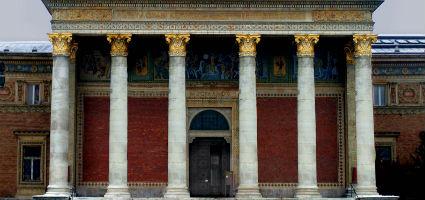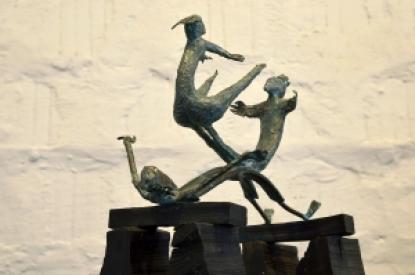2024. April 23. Tuesday
Kunsthalle - Budapest
 |
Address: 1146, Budapest Dózsa György út 37.
Phone number: (1) 460-7000, (1) 363-2671
E-mail: info@mucsarnok.hu
Opening hours: Tue-Wed 10-18, Thu 12-20, Fri-Sun 10-18
|
The exhibition has closed for visitors.
2015.11.04. - 2016.01.31.
Museum tickets, service costs:
|
Ticket for adults
|
1200 HUF
|
|
|
Ticket for adults
(valid for the Kunsthalle and the Ernst Museum)
|
1400 HUF
|
|
|
Group ticket for adults
(from over 10 people)
|
800 HUF
|
/ capita
|
|
Ticket for students
(EU citizens from the age of 6 to 26 )
|
600 HUF
|
|
|
Ticket for students
(valid for the Kunsthalle and the Ernst Museum, 6-26 years of age)
|
700 HUF
|
|
|
Group ticket for students
(from over 10 people)
|
400 HUF
|
/ capita
|
|
Ticket for pensioners
(valid for the Kunsthalle and the Ernst Museum, 62-70 years of age)
|
700 HUF
|
|
|
Ticket for pensioners
(EU citizens from the age of 62 to 70)
|
600 HUF
|
|
|
Ticket for families
(1 adults + 2 children)
|
1800 HUF
|
/ family
|
|
Ticket for families
(2 adults + 2 children)
|
2400 HUF
|
/ family
|
Rarely has there been a Hungarian artist to produce such an evenly and equally high quality work in many different fields as István Malgot. Although Malgot considers himself to be above all a sculptor, he also produced an important body of work in several other fields as well. Műcsarnok will present this unduly unknown, but exceptional oeuvre to the audience in the last months of the year.

The five-decade long career of István Malgot, the sculptor is one of the hidden chapters of Hungarian art history. Although the artist rarely participates at exhibitions, Műcsarnok will now show 69 of his sculptures in the most comprehensive exhibition of his work.
Malgot was captivated by the expressive forces of the live human body at the start of his career as an artist. As a theatre director, as a puppet show and visual effects artist he was one of the central figures of the artistic movements of the 1970s, the founder of the Orfeo group. Later he worked as a writer, a film director, a traveller of East-Asia, a magazine editor, only to return to his roots in the 2000s. Just as he expressed the dramatic tensions of the body both through his theatre performances and film productions and as a writer, his sculptures are all actors in a drama performed on an invisible stage.
The attribution of his sculpture to different periods is difficult first as he never recorded the production dates of his works, second as his approach and artistic position has been extraordinarily consequent and homogeneous. He often used the same ideas, and some of his sculpture were even produced both in wood and in metal, and his works invariably present the immense themes of human suffering, love, pain, exclusion and gratification through the forms of the human body. For Malgot, this is the raw material of art. He moulds human forms, human destinies, and shows us human feelings.
Social responsibility and commitment defines his oeuvre as much as that of Joseph Beuys. But while social responsibility drove Beuys to discover the symbolism of modern mythologies, it urged Malgot towards a rediscovery of the materials of conventional sculpture and towards a human-centered art. His language conjures up the early periods of art history, primarily archaic and tribal art, while flouting archaizing tendencies. He clearly follows the example of the composer Béla Bartók and the poet Attila József: returning to the deeper layers of tradition he purifies and recycles it in the medium of modern urban life.

The five-decade long career of István Malgot, the sculptor is one of the hidden chapters of Hungarian art history. Although the artist rarely participates at exhibitions, Műcsarnok will now show 69 of his sculptures in the most comprehensive exhibition of his work.
Malgot was captivated by the expressive forces of the live human body at the start of his career as an artist. As a theatre director, as a puppet show and visual effects artist he was one of the central figures of the artistic movements of the 1970s, the founder of the Orfeo group. Later he worked as a writer, a film director, a traveller of East-Asia, a magazine editor, only to return to his roots in the 2000s. Just as he expressed the dramatic tensions of the body both through his theatre performances and film productions and as a writer, his sculptures are all actors in a drama performed on an invisible stage.
The attribution of his sculpture to different periods is difficult first as he never recorded the production dates of his works, second as his approach and artistic position has been extraordinarily consequent and homogeneous. He often used the same ideas, and some of his sculpture were even produced both in wood and in metal, and his works invariably present the immense themes of human suffering, love, pain, exclusion and gratification through the forms of the human body. For Malgot, this is the raw material of art. He moulds human forms, human destinies, and shows us human feelings.
Social responsibility and commitment defines his oeuvre as much as that of Joseph Beuys. But while social responsibility drove Beuys to discover the symbolism of modern mythologies, it urged Malgot towards a rediscovery of the materials of conventional sculpture and towards a human-centered art. His language conjures up the early periods of art history, primarily archaic and tribal art, while flouting archaizing tendencies. He clearly follows the example of the composer Béla Bartók and the poet Attila József: returning to the deeper layers of tradition he purifies and recycles it in the medium of modern urban life.


